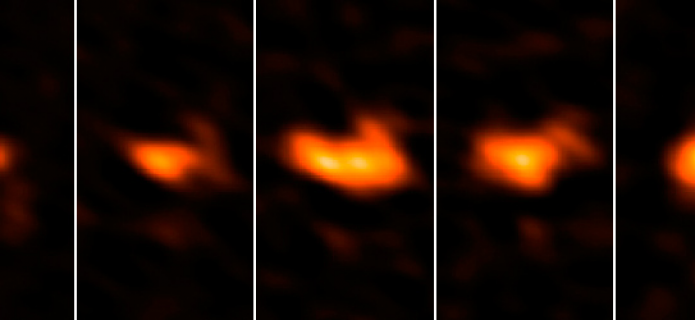ALMA First Radio Imaging with the Band 4 Receiver
The ALMA telescope successfully captured its first radio image with the Band 4 receiver developed by Japan in an ALMA test observation. The target object was IRAS16293-2422, a protostar (baby star) in the constellation of Ophiuchus. The telescope received radio emission from carbon sulfide (CS) molecules surrounding the star and imaged their distribution.
ALMA has 10 receiver bands to cover a wide range of observing frequency. For more effective reception of different bands of frequency, dedicated receivers have been developed for each band. Among them, Japan has assumed the development of three bands: Band 4 (receiving frequency: 125 to 163 GHz); Band 8 (385 to 500 GHz); and Band 10 (787 to 950 GHz).
There are few millimeter/submillimeter receiver products commercially available because radio reception and transmission at these wavelengths not only requires highly advanced techniques but also due to the strong atmospheric absorption, which limits commercial exploitation. For this reason, the National Astronomical Observatory Japan (NAOJ) Advanced Technology Center (ATC) and other partner institutes embarked on the development of high sensitivity receivers for ALMA from 2004. The sensitive heart of the receiver, an SIS device [1], has been developed and fabricated in the ATC clean room, while optical parts and waveguide structures to convey the radio waves to the SIS device were manufactured in the ATC mechanical engineering shop. Each of the Band 4 receivers passes stringent acceptance tests before and after shipment to Chile to ensure that they all fulfill the high-level requirements of ALMA. In June 2010, the first Band 4 receiver successfully detected its first radio spectrum from a target object. After the delivery of further receivers and related commissioning work, the ALMA Band 4 has been used to make the first radio image of an astronomical object. Yoshinori Uzawa, the leader of the Band 4 development team says, "I am so happy to hear the news. During the development phase, we faced many technical challenges, but we pulled together as a team to solve each of them and finally reached here. We expect our receiver will be used by many astronomers around the world to solve the mysteries of the Universe."
Hideo Ogawa, professor at Osaka Prefecture University, who has been deeply involved in the basic technology research for the development of the Band 4 receiver, says, "Development of Band 4 receiver required united efforts of many people, including specialists of superconducting technology, companies with micro-fabrication technique, and skilled researchers engaged in optical design and performance evaluation. This is the result of the state-of-the-art technologies achieved by all partner universities, institutes, and companies in Japan and abroad."
The target of this Band 4 receiver test observation was a protostar IRAS16293-2422 about 400 light years away toward the direction of the constellation of Ophiuchus and it was observed with six 7-m antennas developed by Japan. The baby protostar is surrounded by a large amount of gas that served as a seedbed for the star. This test observation captured radio emission from carbon sulfide (CS) molecules contained in the gas at 147 GHz. Since CS produces strong radio emission in a high gas density region, it is suitable for the observation of gas being soaked into a nearby baby star. Other prospective molecules emitting in the frequency range covered by the Band 4 receiver include formaldehyde (H2CO), deuterium compounds, and carbon chain molecules (a linkage of carbon atoms), which are found in large quantities in cold star forming regions. Tsuyoshi Sawada, a system astronomer at the Joint ALMA Observatory (JAO) who analyzed this radio image, says, "We expect ALMA observation with the Band 4 receiver will provide more data about interstellar matter and promote understanding of the formation process of stars and galaxies yet to be investigated."
Note
[1] SIS is an acronym of "Superconductor-Insulator-Superconductor". As its name suggests, SIS has a sandwich structure with an extremely thin insulator (about 1 nm thick) between two superconducting electrodes. Normally, an insulator blocks the flow of electric current but an extremely thin insulator conducts current due to the quantum tunnelling effect. By measuring this tunnel current, which is a function of the strength and frequency of the incoming radio waves, the SIS device detects faint radio signals at high sensitivity. The size of the SIS junction of the Band 4 receiver is 1.8 square micrometers. The SIS device is manufactured with highly advanced manufacturing technique using thin-film fabrication equipment and exposure equipment like those used for semiconductor production. [back]
More Information
The Atacama Large Millimeter/submillimeter Array (ALMA), an international astronomy facility, is a partnership of Europe, North America and East Asia in cooperation with the Republic of Chile. ALMA is funded in Europe by the European Southern Observatory (ESO), in North America by the U.S. National Science Foundation (NSF) in cooperation with the National Research Council of Canada (NRC) and the National Science Council of Taiwan (NSC) and in East Asia by the National Institutes of Natural Sciences (NINS) of Japan in cooperation with the Academia Sinica (AS) in Taiwan. ALMA construction and operations are led on behalf of Europe by ESO, on behalf of North America by the National Radio Astronomy Observatory (NRAO), which is managed by Associated Universities, Inc. (AUI) and on behalf of East Asia by the National Astronomical Observatory of Japan (NAOJ). The Joint ALMA Observatory (JAO) provides the unified leadership and management of the construction, commissioning and operation of ALMA.
Contact:
Valeria Foncea
Education and Public Outreach Officer
Joint ALMA Observatory
Santiago, Chile
Tel: +56 2 2467 6258
Cell: +56 9 7587 1963
E-mail: [email protected]
Masaaki Hiramatsu
Education and Public Outreach Officer, NAOJ Chile
Observatory
Tokyo, Japan
Tel: +81 422 34 3630
E-mail: [email protected]
Richard Hook
Public Information Officer, ESO
Garching bei München, Germany
Tel: +49 89 3200 6655
Cell: +49 151 1537 3591
Email: [email protected]
Charles E. Blue
Public Information Officer
National Radio Astronomy Observatory
Charlottesville, Virginia, USA
Tel: +1 434 296 0314
Cell: +1 434.242.9559
E-mail: [email protected]
